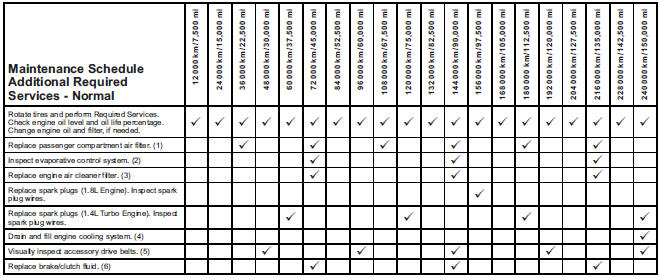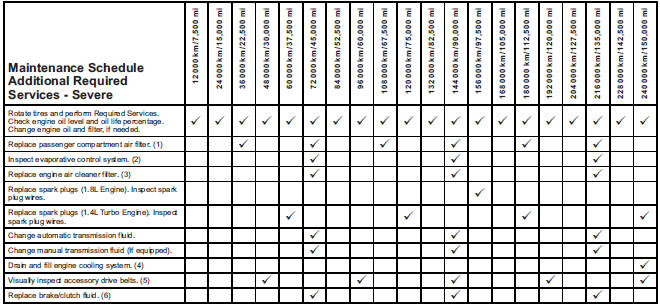Chevrolet Trax: Maintenance Schedule
Owner Checks and Services
At Each Fuel Stop
- Check the engine oil level. See Engine Oil
Once a Month
- Check the tire inflation pressures. See Tire Pressure
- Inspect the tires for wear. See Tire Inspection
- Check the windshield washer fluid level. See Washer Fluid
Engine Oil Change
When the .gif) %CHANGE
(Change Engine Oil Soon) DIC
message displays, have the engine
oil and filter changed within the next
1 000 km/600 mi. If driven under the
best conditions, the engine oil life
system may not indicate the need
for vehicle service for up to a year.
%CHANGE
(Change Engine Oil Soon) DIC
message displays, have the engine
oil and filter changed within the next
1 000 km/600 mi. If driven under the
best conditions, the engine oil life
system may not indicate the need
for vehicle service for up to a year.
The engine oil and filter must be changed at least once a year and the oil life system must be reset.
Your trained dealer technician can perform this work. If the engine oil life system is reset accidentally, service the vehicle within 5 000 km/ 3,000 mi since the last service.
Reset the oil life system when the oil is changed. See Engine Oil Life System
Tire Rotation and Required Services Every 12 000 km/ 7,500 mi
Rotate the tires, if recommended for the vehicle, and perform the following services. See Tire Rotation
- Check engine oil level and oil life percentage. If needed, change engine oil and filter, and reset oil life system. See Engine Oil and Engine Oil Life System
- Check engine coolant level. See Engine Coolant
- Check engine cooling system hoses and connections.
- Check windshield washer fluid level. See Washer Fluid
- Visually inspect windshield wiper
blades for wear, cracking,
or contamination. See Exterior
Care. Replace
worn or damaged wiper blades.
See Wiper Blade Replacement
- Check tire inflation pressures.
See Tire Pressure
- Inspect tire wear. See Tire Inspection
- Visually check for fluid leaks.
- Inspect engine air cleaner filter.
See Engine Air Cleaner/Filter
- Inspect brake system.
- Visually inspect steering, suspension, and chassis components for damaged, loose, or missing parts or signs of wear. See Exterior Care
- Check restraint system components. See Safety System Check
- Visually inspect fuel system for damage or leaks.
- Visually inspect exhaust system and nearby heat shields for loose or damaged parts.
- Lubricate body components. See Exterior Care
- Check starter switch. See Starter Switch Check
- Check automatic transmission shift lock control function. See Automatic Transmission Shift Lock Control Function Check
- Check ignition transmission lock.
See Ignition Transmission Lock Check
- Check parking brake and automatic transmission park mechanism. See Park Brake and P (Park) Mechanism Check
- Check accelerator pedal for
damage, high effort, or binding.
Replace if needed.
- Visually inspect gas strut for signs of wear, cracks, or other damage. Check the hold open ability of the strut. See your dealer if service is required.
- Inspect sunroof track and seal, if equipped. See Sunroof

Footnotes - Maintenance Schedule Additional Required Services - Normal
(1) Or every two years, whichever comes first. More frequent replacement may be needed if the vehicle is driven in areas with heavy traffic, areas with poor air quality, or areas with high dust levels.
Replacement may also be needed if there is a reduction in air flow, excessive window fogging, or odors.
(2) Check all fuel and vapor lines and hoses for proper hook-up, routing, and condition.
(3) Or every four years, whichever comes first.
(4) Or every five years, whichever comes first. See Cooling System
(5) Or every two years, whichever comes first. Inspect for fraying, excessive cracking, or damage; replace, if needed.
(6) Or every three years, whichever comes first.

Footnotes - Maintenance Schedule Additional Required Services - Severe
(1) Or every two years, whichever comes first. More frequent replacement may be needed if the vehicle is driven in areas with heavy traffic, areas with poor air quality, or areas with high dust levels.
Replacement may also be needed if there is a reduction in air flow, excessive window fogging, or odors.
(2) Check all fuel and vapor lines and hoses for proper hook-up, routing, and condition.
(3) Or every four years, whichever comes first.
(4) Or every five years, whichever comes first. See Cooling System
(5) Or every two years, whichever comes first. Inspect for fraying, excessive cracking, or damage; replace, if needed.
(6) Or every three years, whichever comes first.
Special Application Services
- Severe Commercial Use Vehicles Only: Lubricate chassis components every 5 000 km/ 3,000 mi.
- Have underbody flushing service performed. See "Underbody Maintenance" in Exterior Care

